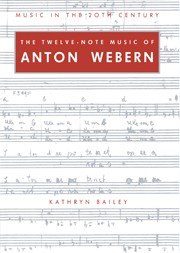Book contents
- Frontmatter
- Contents
- Acknowledgements
- Conventions in the text
- Introduction
- PART I Row and canon
- PART II The instrumental music
- PART III The music with voices
- Conclusion
- Appendices
- I A comparison of row characteristics
- II Matrices
- III Row analyses (1)
- IV Row analyses (2)
- V A note on Webern's graces
- Notes
- Glossary
- Chronological worklist
- Select bibliography
- Index
III - Row analyses (1)
Published online by Cambridge University Press: 23 December 2009
- Frontmatter
- Contents
- Acknowledgements
- Conventions in the text
- Introduction
- PART I Row and canon
- PART II The instrumental music
- PART III The music with voices
- Conclusion
- Appendices
- I A comparison of row characteristics
- II Matrices
- III Row analyses (1)
- IV Row analyses (2)
- V A note on Webern's graces
- Notes
- Glossary
- Chronological worklist
- Select bibliography
- Index
Summary
This appendix and the one following are intended to be used together. They present a row analysis of each of the works from Op. 20 to Op. 31, as it were from two perspectives. Appendix III gives the row content of each movement within a formal outline; Appendix IV represents a closer view, in which the precise deployment of all the rows appearing in Appendix III is indicated. An attempt has been made to preserve structural units in the layout of the charts in Appendix IV; however, in some cases this has not been possible because of space limitations. Whereas the primary objective of the Appendix III analyses is to illustrate the way in which the rows fill out the structure, details of individual row distribution take precedence in Appendix IV.
The analyses in the text are based on a single row form for each work: with the exception of Op. 24, that form identified as the original by Webern in the sketchbooks. However, just as in tonal music all the movements of an extended work are not in the same key, so in the case of Webern's twelve–note music the several movements of a single work are not all centred tonally on the same row. In order to illustrate the tonal analogy in those movements that are as it were ‘in another key’, alternative analyses are provided in which the matrix has been reoriented.
In both this appendix and the one following, bar numbers identifying beginnings of sections ignore short anacruses.
- Type
- Chapter
- Information
- The Twelve-Note Music of Anton WebernOld Forms in a New Language, pp. 344 - 353Publisher: Cambridge University PressPrint publication year: 1991

